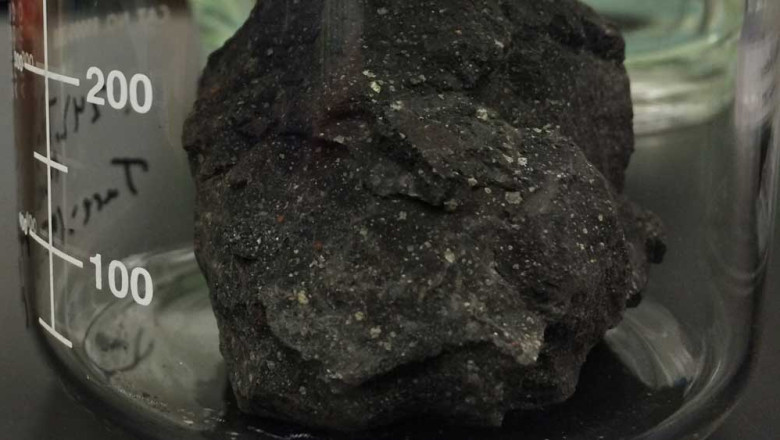
views
All of the bases in DNA and RNA have now been found in meteorites
A 2-gram chunk from this rock — a piece of the meteorite that fell near Murchison, Australia, in 1969 — contains two crucial components of DNA and RNA now identified for the first time in an extraterrestrial source, researchers say.
NASA
By Liz Kruesi
April 26, 2022 at 11:00 am
More of the ingredients for life have been found in meteorites.
Space rocks that fell to Earth within the last century contain the five bases that store information in DNA and RNA, scientists report April 26 in Nature Communications.
These “nucleobases” — adenine, guanine, cytosine, thymine and uracil — combine with sugars and phosphates to make up the genetic code of all life on Earth. Whether these basic ingredients for life first came from space or instead formed in a warm soup of earthly chemistry is still not known (SN: 9/24/20). But the discovery adds to evidence that suggests life’s precursors originally came from space, the researchers say.
Headlines and summaries of the latest Science News articles, delivered to your email inbox every Thursday.
Thank you for signing up!
There was a problem signing you up.
Scientists have detected bits of adenine, guanine and other organic compounds in meteorites since the 1960s (SN: 8/10/11, SN: 12/4/20). Researchers have also seen hints of uracil, but cytosine and thymine remained elusive, until now.
“We’ve completed the set of all the bases found in DNA and RNA and life on Earth, and they’re present in meteorites,” says astrochemist Daniel Glavin of NASA’s Goddard Space Flight Center in Greenbelt, Md.
A few years ago, geochemist Yasuhiro Oba of Hokkaido University in Sapporo, Japan, and colleagues came up with a technique to gently extract and separate different chemical compounds in liquified meteorite dust and then analyze them.
“Our detection method has orders of magnitude higher sensitivity than that applied in previous studies,” Oba says. Three years ago, the researchers used this same technique to discover ribose, a sugar needed for life, in three meteorites (SN: 11/22/19).
In the new study, Oba and colleagues combined forces with astrochemists at NASA to analyze one of those three meteorite samples and three additional ones, looking for another type of crucial ingredient for life: nucleobases.
The researchers think their milder extraction technique, which uses cold water instead of the usual acid, keeps the compounds intact. “We’re finding this extraction approach is very amenable for these fragile nucleobases,” Glavin says. “It’s more like a cold brew, rather than making hot tea.”
With this technique, Glavin, Oba and their colleagues measured the abundances of the bases and other compounds related to life in four samples from meteorites that fell decades ago in Australia, Kentucky and British Columbia. In all four, the team detected and measured adenine, guanine, cytosine, uracil, thymine, several compounds related to those bases and a few amino acids.
Get great science journalism, from the most trusted source, delivered to your doorstep.
Using the same technique, the team also measured chemical abundances within soil collected from the Australia site and then compared the measured meteorite values with that of the soil. For some detected compounds, the meteorite values were greater than the surrounding soil, which suggests that the compounds came to Earth in these rocks.
But for other detected compounds, including cytosine and uracil, the soil abundances are as much as 20 times as high as in the meteorites. That could point to earthly contamination, says cosmochemist Michael Callahan of Boise State University in Idaho.
“I think [the researchers] positively identified these compounds,” Callahan says. But “they didn’t present enough compelling data to convince me that they’re truly extraterrestrial.” Callahan previously worked at NASA and collaborated with Glavin and others to measure organic materials in meteorites.
But Glavin and his colleagues point to a few specific detected chemicals to support the hypothesis of an interplanetary origin. In the new analysis, the researchers measured more than a dozen other life-related compounds, including isomers of the nucleobases, Glavin says. Isomers have the same chemical formulas as their associated bases, but their ingredients are organized differently. The team found some of those isomers in the meteorites but not in the soil. “If there had been contamination from the soil, we should have seen those isomers in the soil as well. And we didn’t,” he says.
Going directly to the source of such meteorites — pristine asteroids — could clear up the matter. Oba and colleagues are already using their extraction technique on pieces from the surface of the asteroid Ryugu, which Japan’s Hayabusa2 mission brought to Earth in late 2020 (SN: 12/7/20). NASA’s OSIRIS-REx mission is expected to return in September 2023 with similar samples from the asteroid Bennu (SN: 1/15/19).
“We’re really excited about what stories those materials have to tell,” Glavin says.
Questions or comments on this article? E-mail us at [email protected]
A version of this article appears in the June 4, 2022 issue of Science News.
Y. Oba et al. Identifying the wide diversity of extraterrestrial purine and pyrimidine nucleobases in carbonaceous meteorites. Nature Communications. April 26, 2022. doi: 10.1038/s41467-022-29612-x.
Liz Kruesi is a freelance science journalist who focuses on astronomy. She is based in Colorado.
Our mission is to provide accurate, engaging news of science to the public. That mission has never been more important than it is today.
As a nonprofit news organization, we cannot do it without you.
Your support enables us to keep our content free and accessible to the next generation of scientists and engineers. Invest in quality science journalism by donating today.




















Comments
0 comment